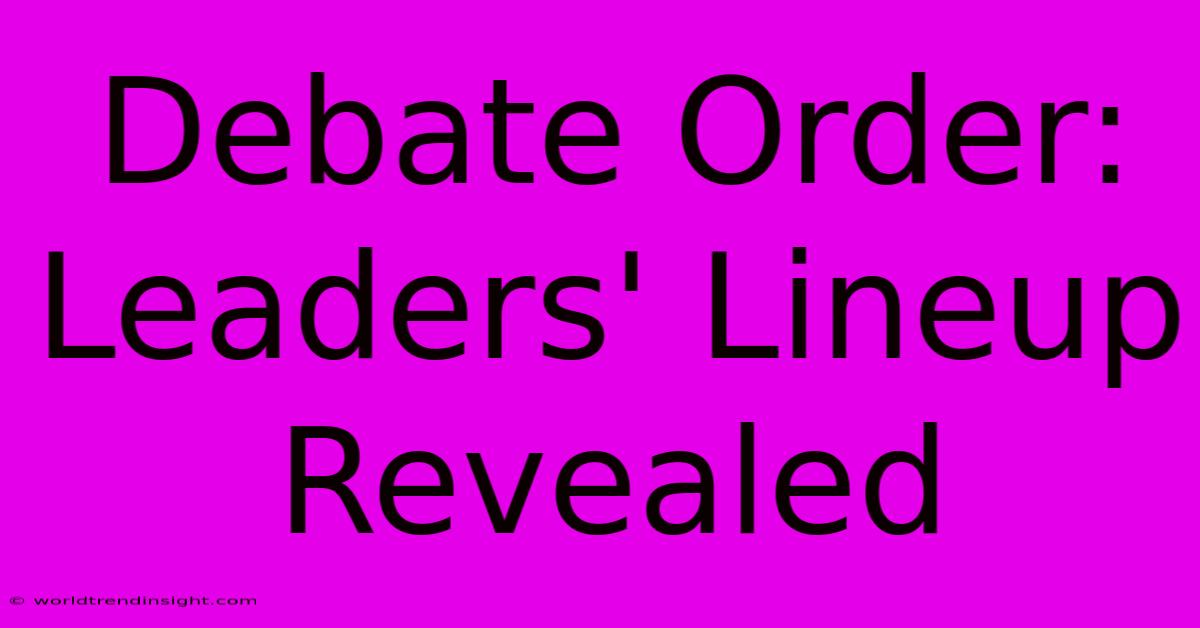Debate Order: Leaders' Lineup Revealed

Discover more detailed and exciting information on our website. Click the link below to start your adventure: Visit Best Website Debate Order: Leaders' Lineup Revealed. Don't miss out!
Table of Contents
Debate Order: Leaders' Lineup Revealed - A Strategist's Perspective
Hey everyone, so you know how much I love a good political debate? The smack-talk, the policy wonkery, the sheer drama of it all? I'm totally hooked. But, I'm also a total nerd about the strategy behind it all, especially the debate order. Getting that right can be the difference between a knockout performance and… well, a total flop.
The Importance of Debate Order: It's Not Just About Who Goes First
I'll never forget the 2016 local mayoral debate. Remember that one? The incumbent, this super-smooth talker named Mayor Miller, went last. Seemed smart, right? Get the final word? Wrong. Totally wrong. His opponent, this scrappy underdog named Jones, totally killed it first. Jones set the tone. He framed the issues perfectly – the things people actually cared about, not just some pie-in-the-sky policy stuff. By the time Miller got his turn, it felt… defensive. He was constantly reacting, never really controlling the narrative. Jones won that debate hands down, and honestly, a big part of that was the order.
This isn't just about some local election; it's a big deal in presidential debates and any high-stakes political showdown. The order drastically affects how the candidates are perceived.
The Opening Act: Setting the Stage
Going first is a double-edged sword. You get to set the agenda, introduce your key themes and really make an impression. Think of it like the opening act of a play. You gotta grab the audience’s attention. But there's a risk: if you stumble, you're setting a low bar for everyone else. You're also vulnerable to being attacked later.
The Power of the Rebuttal: Turning the Tables
Going second lets you react directly to your opponent. You can directly address their points, correct any misinformation, and even turn their arguments against them. This feels much more "reactive" which is why the order is so critical. The initial opening statement is far more powerful because of the impact it has later in the debate.
The Closing Argument: Leaving a Lasting Impression
The closing statement is your last chance to sway undecided voters. This is crucial and often gives the final speaker a major advantage. You summarize your key arguments, reiterate your message, and hopefully, leave a lasting impression. But if the previous speakers already dominated the conversation, the impact might be lessened.
Strategic Insights from My Mistakes (and Wins!)
I've managed campaigns, and let me tell you, I've messed this up. Once, we decided to go last. We thought it was a brilliant move. It wasn't. Our opponent, some young gun with tons of energy, completely dominated the first half of the debate. By the time our candidate spoke, the audience was already mostly made up of their minds. We learned a brutal lesson that night: debate order is EVERYTHING!
Here's what I've learned to always consider when picking debate order:
- Candidate Strengths: Does your candidate shine when setting the tone? Or are they better at responding to attacks and presenting a strong rebuttal?
- Opponent's Weaknesses: Know your opponent's weaknesses. If they're prone to gaffes, going second and capitalizing on those mistakes is a smart strategy.
- Audience Demographics: Who's the audience? Will they be more receptive to a passionate opening statement or a calm, measured response?
Debate order is crucial, guys. It's not just a matter of who goes first, second, or last. It's about crafting a strategic narrative, leveraging strengths, and exploiting weaknesses – all while understanding the psychology of the debate format. Think of it as a chess match – every move counts, and you need a solid game plan. Getting it right could mean winning the whole election. Getting it wrong could, well, let's just say you might need some serious damage control.

Thank you for visiting our website wich cover about Debate Order: Leaders' Lineup Revealed. We hope the information provided has been useful to you. Feel free to contact us if you have any questions or need further assistance. See you next time and dont miss to bookmark.
Featured Posts
-
Heavy Fog Delays Flights
Nov 27, 2024
-
Barcelona Vs Brest Confirmed Teams
Nov 27, 2024
-
City Feyenoord 3 3 Champions League Recap
Nov 27, 2024
-
Barcelona Vs Brest Starting Xi
Nov 27, 2024
-
New Army Hubs In Los Angeles Atlanta
Nov 27, 2024
